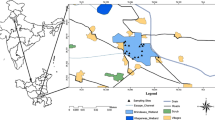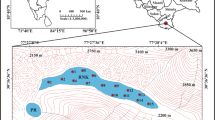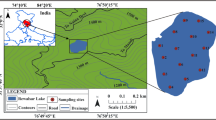Abstract
Large and growing population and rapid pace of development have led to the degradation of natural water system. Lakes are inland bodies of water that lack any direct exchange with an ocean. Lakes may contain fresh or saltwater (in arid regions), shallow or deep, permanent or temporary lakes of all types which share many ecological and biogeochemical processes. Lake ecosystems are influenced by their watersheds, i.e., the geological, chemical, and biological processes that occur on the land and streams. Lakes play multiple roles in an urban setting. It is essential to restore and maintain the physical, chemical, and biological integrity of water bodies to achieve the required water quality, which ensure protection and propagation of fish, wildlife, plants, and also recreation in and on water. The overall goal of this study is to monitor the water quality and assess the trophic status of Bhalswa Lake in Delhi. The trophic status was assessed by using multivariate indices including Carlson Trophic Status Index (CTSI) Sakamoto, Academy and Dobson index, and USEPA-NES which primarily used total phosphorus, chlorophyll-a, and Secchi depth parameters. This study showed that the Bhalswa Lake is in moderate eutrophic condition during the monsoon and post-monsoon period.
Access provided by Autonomous University of Puebla. Download conference paper PDF
Similar content being viewed by others
Keywords
- Water quality
- Lake ecosystem
- Trophic status index
- Phosphorus
- Chlorophyll-a and secchi depth
- Eutrophication
1 Introduction
The meaning of the word trophic is “related to nutrition”. Trophic continuum is divided into four classes traditionally such as: (1) Oligotrophic (limited or deficient); (2) mesotrophic (medium-range); (3) eutrophic (good or great enough); and (4) hypereutophic (extensive). Multidimensional trophic concept was used before the TSI based upon the single criterion, including supply rate of organic matter to the lake. But that criterion was doubtful because of a single parameter determination. The optimal Trophic Status Index (TSI) maintains the interpretation of trophic status components found in multiparameter indicators. However, TSI still has a single variable coefficient at its ease, and it can be accomplished when interrelated with the frequently used trophic criteria. The researchers reported an empirical equation to predict the concentration of phosphorus in lakes based on awareness of phosphorus loading. The link between the amount of phosphorus and microalgae production is chlorophyll-a concentration. In 1975, if a series of predictive equations could relate several of the trophic requirements frequently used, measuring all possible trophic parameters would no longer be necessary to determine trophic position. A single trophic metrics like biomass of algae, loading of nutrients, or concentration of nutrients could be the foundation for an index from which to estimate or predict other trophic requirements through the defined interactions. Alternatively, for determining the trophic condition, one of trophic requirements can also be used.
TSI is an index that would promote communication between the public and the limnologist, which is particularly vulnerable to such concerns. Algal biomass values is a difficult term, and some variables including dry and wet weight, molecule amount, chlorophyll-a, carbon amount, and Secchi disk can generally be estimated.
2 Objectives of the Study
Following are the objectives of study:-
-
To characterize Bhalswa Lake on the basis of Trophic Status Index (TSI).
-
To identify the probable sources of pollutants in Bhalswa Lake.
-
To suggest corrective/restoration options for improvement in lake trophic status index.
3 Methodology
The methodology of present study is according to the procedure recommended in APHA (1992) and NEERI (1991) guidelines for water quality. The lake is divided in small blocks, and samples were collected from different sampling locations for the representation of the quality of water of Bhalswa Lake. The samples were collected through boats provided by Delhi Tourism.
3.1 Trophic Status Index
Trophic Status Index (TSI) is a conventional measure or instrument used to calculate a lake's trophic status or productivity. More specifically, at a particular place and moment, it is the complete living plankton weight throughout water system, Three factors estimate algal biomass separately, (a) chlorophyll, (b) Secchi depth, and (c) complete phosphorus. There is a connection between phosphorus, chlorophyll-a (concentration of algae), and Secchi depth. This implies more food is accessible for algae when phosphorus rises, so algal concentrations rise. The water becomes less transparent when algal concentrations rises and the depth of Secchi reduces. The resulting numbers cover different components and ranges from all these three calculations, so it cannot be compared or averaged directly with each other. Three trophic status index readings used an equation to standardize them in order to make them instantly comparable. A lake's overall trophic status index (TSI) is the phosphorus median TSI, the Secchi depth TSI, and thus the chlorophyll-a TSI; therefore, considering phosphorus, Secchi depth, and chlorophyll-a, it can be considered as the lake condition. It is essential to realize that in phosphorus and algal concentration, trophic status is defined divisions of a continuum. The TSI is between 0 and 100. Oligotrophic 0–30 is very clear water, low phosphorus, and sparse algae. 30–50 is an intermediate phase where, owing to more accessible phosphorus, the number of aquatic plant algae increases. A TSI of over 50 defines a lake that is eutrophic, with an elevated plant and algae density that may be difficult to swim in the summer at certain times. Some lakes can be eutrophic naturally, having a TSI of 50 or higher over the last 100 years. As a consequence of human operations, other lakes have gradually risen in TSI. Not necessarily, the Trophic Status Index can be interchanged with water quality. The quality of water is subjective and depends on how the water body is to be used. A lake which is great for duck hunting is not necessarily nice for water skiing. In turn, bass fishing may not be good for a lake that is good for swimming. The different attributes with respect to different parameters of TSI are mentioned in Table 1.
The relationships are not always simple between the three TSI calculations. Carlson pointed out that highly stained lakes with large amounts of organic material submerged in them can generate elevated Secchi transparency TSI scores that do not suit the model because the water color affects the depth at which the Secchi disk falls. The type and volume of the prevalent algae population might also influence the writing of Secchi the algae types may vary in the amount of pigment they carry.
3.2 TSI Values Uses
It is possible to use TSI scores to rank lake between and within geographical areas. This categorization enables water supervisors to select lakes which may require restoration or preservation. An increasing sequence in TSI standards over many decades may demonstrate degradation in the wellness of a lake.
3.3 Factors Influencing the TSI Values
The less possibility that a potentially harmful cyanobacteria will occur might stop more and more presence of phosphorus. It is recognized that perhaps the cyanobacteria typically accountable for producing contaminants are poor competitors of phosphorus, so the accessible levels must have been huge until they do anything in water. Phosphorus emissions can be reduced with well-designed stormwater runoff catchment processes, renovation of sewer facilities, changing householders and business practices (such as not utilizing phosphorus-rich chemicals on gardens), training and rewards, and replacing septic watershed structures with sewers.
The TSI is a useful tool for the management of lake water and also a useful science instrument of research where a trophic status standard is required. The TSI can serve as a trophic status assessment about many of biological and chemical elements of river system linked to the trophic status which can be compared. Outcome might be fuller and dynamic image of how these elements relate to each other and the ecosystems of the lake as a whole.
In this study, different analytical parameters are studied for the determination of WQI and TSI (Table 2).
3.4 Parameters Studied for the Evaluation of TSI
-
1.
Determination of Secchi disc depth
-
2.
Determination of total chlorophyll -a
-
3.
Determination of total phosphate
-
4.
Trophic Status Index
-
5.
Trophic State Index (TSI)
-
6.
Secchi depth transparency (SD).
4 Results
4.1 Determination of TSI (SD)
The values of TSI SD for Bhalswa Lake in the monsoon and post-monsoon seasons are represented in Table 3, and graphical rep. of comparison of TSI SD is shown in Fig. 1 mentioned below. The values of TSI SD for monsoon season are maximum at location S5, and it is minimum for location S1 and S13. And the value of TSI SD for post-monsoon season is maximum at location S6, and it is minimum for location S3.
4.2 Determination of Total Chlorophyll-A (TChl)
The values of total chlorophyll-a, for Bhalswa Lake in the monsoon and post-monsoon seasons are represented in Table 4, and graphical representation of the comparison of TSI-Chl is shown in Fig. 2 as mentioned below
4.3 Determination of Total Phosphorous
The comparison of mean values of total phosphorous of all 13 locations from Bhalswa Lake was represented in Table 5 during monsoon and post-monsoon season, and graphical representation of the comparison of TSI-TP is shown below.
The graphical representation of the comparison in between the TSI-TP values in different seasons is shown in Fig. 3.
The comparison of the SD + CHL + TP/3 values for all 13 sampling locations is mentioned in Table 6 and graphical representation of the values is shown in Fig. 4.
4.4 Determination of Total TSI
The TSI values for all different locations are mentioned in Table 7 and Fig. 5. The values of TSI were in between the range of 69–103, and mean values for monsoon and post-monsoon season were 96.06 ± 6.78 and 86.89 ± 10.53, respectively. The formula used for the calculation of Carlson’s Trophic Status Index is mentioned following under:
4.5 Carlson’s Trophic Status Index (C-TSI) = [TSI (TP) + TSI(CA) + TSI(SD)]/3
Mesotrophy (moderate productivity) is generally associated with index with a range in between 40–50 value; and index value more than 50 showed eutrophy status; value less than 40 are correlated with oligotrophy (low productivity). The values of the three factors, index and more than their characteristics for each parameter. Lake Bhalswa has been categorized as hypereutrophic. If it can be associated with particular occurrences within a water body, any Trophic Status Index gains value. The list of possible modifications in the body of water may happen. Some features, such as hypolimnitic oxygen or fish, may differ slightly and may not be linked to real TSI at times. Bhalswa Lake TSI values were discovered to be 69–103 in both monsoon season and post-monsoon season, and average TSI values were found to be 96 and 86, respectively, for the monsoon and post-monsoon seasons. This can be ascribed to Bhalswa Lake eutrophy, where anoxic hypolimia and macrophy issues are quite feasible.
Conservation can be performed under such conditions by removing hydrophytic macrophytes and introducing hot water fish. Under these conditions, blue, green algae dominate especially that of M. aeruginosa, foul smell come from the water and the water transparency decreases. TP increases significantly resulting in high productivity restricted, thick algae development.
5 Discussion
A close look at the lake shows that dense scums of algal, decreased macrophytes, foul smelling water lead to enormous fish murderers. It can be reduced only by draining the whole water and again refill it by harvesting rainwater. Eutrophication monitoring is a significant component of the evaluation and management of lake ecosystems. Phosphorous is initially the algae nutrient-limiting development. These results in direct and indirect biological modifications in lakes that lead to algal blooms being produced. Indirect eutrophication during the breakdown of the dead algae mass might be leads to depletion in dissolved oxygen concentration as a consequence of bacterial respiration. According to Carlson (1980), the interrelationship between the parameters can use for the assessment of quality of water for lakes. Corrective measures and lake restoration methods are crop management, live stock management, land farming, sewage water treatment, water treatment, and artificial floating islands. Suggestions from the study are that the data related to various physiochemical characteristics of water of Bhalswa Lake can be utilized as a baseline and reference value for future research work and some necessary steps can be taken on the basis of the result which is obtained from my study. Concerned authorities should take care of the lakes, necessary rules should be formed, and the violator should be charged penalty. Then only, this lake can be saved, otherwise one more lake will be lost.
6 Conclusion
Based on the above study, following conclusions can be made:-
-
1.
The major reason may be the organic waste coming from neighboring dairies, poured directly into the Bhalswa Lake, which increases organic pollution and decreased dissolved oxygen leading to anoxic conditions in lake water, decreased DO value which is < 4, further will affect aquatic life.
-
2.
Also lake is polluting due to inorganic waste coming from nearby landfill sites and various small factories nearby lake which are discharging their untreated waste matter directly into the lake.
-
3.
If this process will continue, then lake will be no longer a place of recreational activity. Immediate action is needed to revive the lake. Otherwise, one more lake will be lost.
References
Sakshi SK, Singh Haritash AK (2017) Environmental biotechnology for control of environmental pollution. In: Proceedings of international conference on emerging areas of environmental science and engineering EAESE-2017, February 16–18, 2017
Shan V, Singh SK, Haritash AK (2017) Water quality Indices to determine the surface water quality of Bhindawas Wetland. In: Proceedings of international conference on emerging areas of environmental science and engineering EAESE-2017, February 16–18, 2017
Gour A Singh SK, Mandal A (2016) Occupational Hazard Posed to labourer operators at landfill sites. In: Proceeding of 3rd International conference on occupational and Environmental Health, 23–25 Sept 2016, New Delhi
Singh SK, Anunay G, Rohit G, Shivangi G and Vipul V (2016) Greenhouse gas emissions from landfills: a case of NCT of Delhi, India. J Climatol Weather Forecast
Gupta D, Singh SK (2015) Energy use and greenhouse gas emissions from waste water treatment plants. Int J Environ Eng-Indersci 7(1):1–10. https://doi.org/10.1504/IJEE.2015.069251
Jaffar MM, Shebli MK, Mussa AKA, Hadi BH, Aenab AM, Singh SK (2015) Detection of Enterobacter sakazakii from Commercial Children Dry Milk. Journal of Environmental Protection 2015 (6), 1170–1175
Singh SK, DhruvKatoriya DM, Sehgal D (2015) Fixed bed column study and adsorption modelling on the Adsorptim of malachite green day from wastewater using acid activated sawdust. Int J Adv Res 3(7):521–529
Abtahi M, Golchinpour N, Yaghmaeian K, Rafiee M, Jahangiri-rad M, Keyani A, Saeedi R (2015) A modified drinking water quality index (DWQI) for assessing drinking source water quality in rural communities of Khuzestan Province. Iran Ecol Indic 53:283–291. https://doi.org/10.1016/J.ECOLIND.2015.02.009
Alam M, Pathak JK (2010) Rapid assessment of water quality index of ramganga river, Western Uttar Pradesh (India) using a computer programme. Nat Sci 8:1–8
Avvannavar SM, Shrihari S (2008) Evaluation of water quality index for drinking purposes for river Netravathi, Mangalore, South India. Environ Monit Assess 143:279–290. https://doi.org/10.1007/s10661-007-9977-7
Bhargava D, Saxena B, Dewakar R (1970) A study of the geopollutants in the Godavary river basin of India. Asian Environ 78:1–4
BIS (1991) Water quality standards indian standard drinking water specification, Bureau of Indian Standard, Indian Standard (10500)
Branchu P, Bergonzini L, Ambrosi J-P, Cardinal D, Delalande M, Pons-Branchu E, Benedetti M (2010) Hydrochemistry (major and trace elements) of Lake Malawi (Nyasa), Tanzanian Northern Basin: local versus global considerations. Hydrol Earth Syst Sci Dis 7:4371–4409. https://doi.org/10.5194/hessd-7-4371-2010
Chandra S, Singh A, Tomar PK (2012) Assessment of water quality values in Porur Lake Chennai, Hussain Sagar Hyderabad and Vihar Lake Mumbai. India Chem Sci Trans 1:508–515. https://doi.org/10.7598/cst2012.169
Chauhan A, Singh S (2010) Evaluation of ganga water for drinking purpose by water quality index at Rishikesh, Uttarakhand. India Rep Opin 2:53–61
Devi Prasad AG (2012) Carlson’s trophic status index for the assessment of trophic status of two Lakes in Mandya district. Adv Appl Sci Res 3:2992–2996
Dwivedi S, Tiwari I, Bhargava D (1997) Water quality of the river Ganga at Varanasi. Inst Eng Kolkota 78:1–4
Fadiran A, Dlamini S, Mavuso A (2008) A comparative study of the phosphate levels in some surface and ground water bodies of swaziland. Bull Chem Soc Ethiop 22:197–206
Goher ME, Hassan AM, Abdel-Moniem IA, Fahmy AH, El-sayed SM (2014) Evaluation of surface water quality and heavy metal indices of Ismailia Canal, Nile River Egypt. Egypt J Aquat Res 40:225–233. https://doi.org/10.1016/J.EJAR.2014.09.001
Joshi DM, Kumar A, Agrawal N (2009) Studies on physicochemical parameters to assess the water quality of river ganga for drinking purpose In: Haridwar District 2:195–203
Author information
Authors and Affiliations
Corresponding author
Editor information
Editors and Affiliations
Rights and permissions
Copyright information
© 2021 The Author(s), under exclusive license to Springer Nature Singapore Pte Ltd.
About this paper
Cite this paper
Dagar, S., Singh, S.K. (2021). Seasonal Behavior of Trophic Status Index of a Water Body, Bhalswa Lake, Delhi (India). In: Singari, R.M., Mathiyazhagan, K., Kumar, H. (eds) Advances in Manufacturing and Industrial Engineering. ICAPIE 2019. Lecture Notes in Mechanical Engineering. Springer, Singapore. https://doi.org/10.1007/978-981-15-8542-5_15
Download citation
DOI: https://doi.org/10.1007/978-981-15-8542-5_15
Published:
Publisher Name: Springer, Singapore
Print ISBN: 978-981-15-8541-8
Online ISBN: 978-981-15-8542-5
eBook Packages: EngineeringEngineering (R0)









